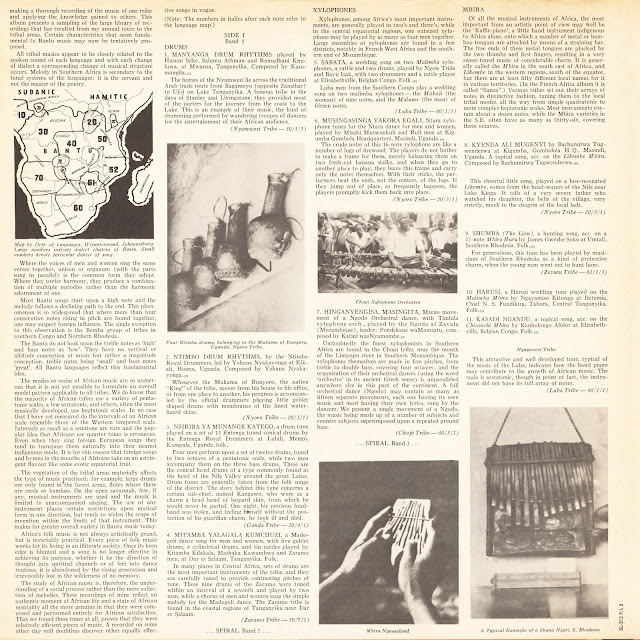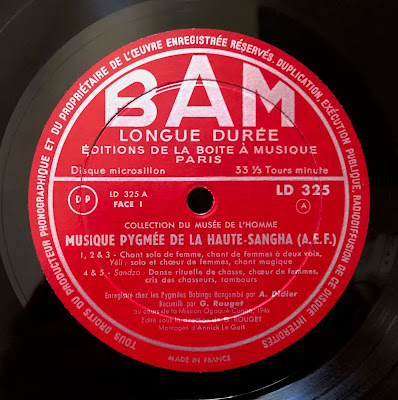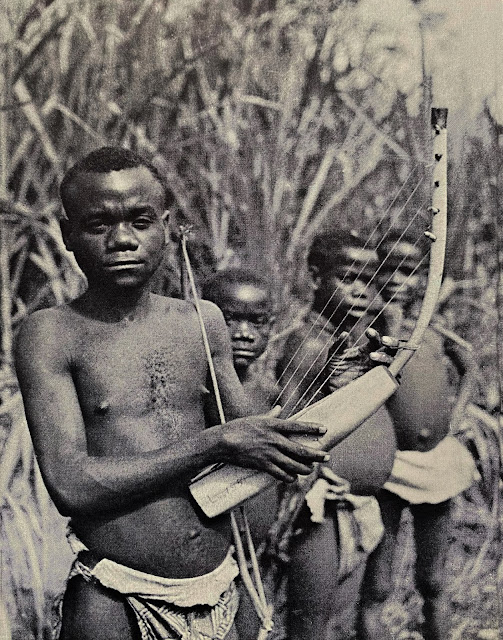TANZANIA – ZIMBABWE – UGANDA – KENYA – CONGO – MALAWI – MOZAMBIQUE – ZAMBIA – LESOTHO
British East Africa – Columbia Masterworks Volume X – SL 213, collected and edited by Alan Lomax and Hugh Tracey, 1955 (LP)
We now present an excellent panorama of East African music from the early 1950s recorded by the great American ethnomusicologist and folklorist Alan Lomax (1915-2002), whose many recordings helped preserve folk musics and was central in the American and British folk revival between the 1940s and 1960s. These recordings were edited by the distinguished English ethnomusicologist Hugh Tracey (1903-1977), who for five decades tirelessly traveled to Southern and Central Africa, where he made 35,000 recordings of disappearing traditional and folk musics.
These superb tracks, recorded in Uganda, Kenya, Tanzania, Zimbabwe, Congo-Kinshasa, Mozambique, Malawi, Zambia and Lesotho in the early 1950s, are presented by type of instrument, including drum music, xylophones, the Mbira African thumb piano, musical bows, flutes, zithers, lyres, story songs and country dance songs.
Nous présentons maintenant un excellent panorama de musiques d'Afrique de l'Est enregistrées au début des années 1950 par le grand ethnomusicologue et folkloriste américain Alan Lomax (1915-2002) qui contribua à préserver les musiques folkloriques du monde et joua un rôle déterminant dans le renouveau folk américain et britannique entre les années 1940 et 1960. Ces enregistrements ont été édités par l'éminent ethnomusicologue anglais Hugh Tracey (1903-1977), qui parcouru sans relâche l’Afrique australe et centrale pendant cinq décennies au cours desquelles il réalisa 35 000 enregistrements de musiques traditionnelles et folkloriques en voie de disparition.
Ces superbes morceaux enregistrés en Ouganda, au Kenya, en Tanzanie, au Zimbabwe, au Congo-Kinshasa, au Mozambique, au Malawi, en Zambie et au Lesotho au début des années 1950 sont présentés par type d'instrument notamment les tambours, les xylophones, le piano à pouce africain mbira, les archets musicaux, les flûtes , les cithares, les lyres, et chansons d'histoire et chansons de danses rurales.
Drum Music
A1 – Manyanga Drum Rhythms - Nyamwezi people, Mwanza, Tanzania.
Drums by Husuni Isike, Ramadhani Knuluwa, and Salumu Athman;
Composed by Kasomangila.
A2 – Ntimbo Drum Rhythms - Nyoro people, Kikali, Hoima, Uganda.
Ntimbo Royal Drummers; Leader and composer: Yohana Nyakayonga.
A3 – Nsiriba Ya Munange Katego - Ganda people, Lubiri (Mengo Palace), Kampala, Uganda.
Ensemble: Entenga Royal Drummers.
A4 – Mitamba Yalagala Kumchuzi (Madogili dance) - Zaramo people, Dar es Salaam, Tanzania.
Drums, rattles by Kitamba, Kilakala, Mashaka, Kawambwa, and Zaramo men.
Xylophones
A5 – Sabata (wedding song) - Luba people, Lubumbashi, Congo-Kinshasa.
Drums, rattles, two Malimba xylophones.
A6 – Musingasinga Yakora Egali (Ntara dance) - Nyoro people, Masindi, Uganda.
Ntara xylophones by Misaki Muswankuli and Ruli men.
A7 – Hinganyengisa Masingita (Ngodo orchestral dance) - Chopi people, Zavala, Mozambique.
Timbila Xylophone Orchestra led by Pondekane WaMamzatu;
Composed by Katini WaNyamombe.
Mbira
A8 – Kyenda Ali Mugenyi - Nyoro people, Kigumba, Gombolola H.Q., Masindi, Uganda.
Likembe mbira;
Composed by Bachumirwa Tugwenderwa.
A9 – Shumba (The Lion) hunting song - Zezuru people, Mutare, Zimbabwe.
Huru mbira by James Gwezhe Soko.
A10 – Harusi (Wedding Tune) - Nyamwezi people, Tabora, Tanzania.
Malimba mbira by Ngayamiso Kitunga.
A11 – Kasadi Ngandu - Luba people, Lubumbashi, Congo-Kinshasa.
Chisanzhi mbira by Kankolongo Alidor.
A12 – Citombe (dance tune) - Shona/Karanga people, Masvingo, Zimbabwe.
Njari mbira by Mukomondera Moye.
A13 – Chirombo Weye Nditerere - Shona/Karanga people, Masvingo, Zimbabwe.
Kalimba mbira, vocals by Mugadzikwa Mwanagona.
Musical Bows
A14 – Teera Machangwa - Shona/Karanga people, Masvingo, Zimbabwe.
Chizambi musical bow by Mukomondera Moyo.
A15 – Kwa Ambuya Asina Keriya - Zezuru people, Harare, Zimbabwe.
Chipendane musical bows by Muchabaiwa, Remigion, and Richard.
Flutes
A16 – Okuzanyira Ku Nyanja - Ganda people, Lubiri (Mengo Palace), Kampala, Uganda.
Flutes and drums.
Gourds
B1 – Manyanda (Muganda dance) - Chewa people, Masula, Lilongwe District, Malawi.
Malipenga singing gourds; leader Benson Phiri.
Zithers
B2 – Hehe Song - Hehe people, Iringa, Tanzania.
Ligombo tube-zither by Pancras Mkwawa.
B3 – Dale Wangu - Tonga people, Nkhata Bay, Malawi.
Bangwe raft-zither by Beti Kamanga.
B4 – Mugasha - Haya people, Bukoba, Tanzania.
Nanga trough-zither by Habib Bin Seliman.
Lyres
B5 – Naftali Ouko - Luo people, Kisii, Kenya.
Thum eight-string lyre, Gara leg bells by Daudi Otuoma.
B6 – Wachonge - Bukusu people, Mumias, Kenya.
Story Songs
B7 – Pfeni Nengoma - Ndau/Garwe people, Mutare, Zimbabwe.
Vocals by Muchaenna Sigauke and Ndau men.
B8 – Teya-Teya - Lozi people, Kitwe, Zambia.
Albert Mulope and the Barotseland Patriotic Society Choir.
B9 – Pi Mcinanga - Zezuru people, Penhalonga, Zimbabwe.
Teacher Training College Choir and rattle.
B10 – Kamwezi Sensa Muyaya - Nyamwezi people, Dar es Salaam, Tanzania.
Vocals, Drums by Idi Selemani and Nyamwezi men and women.
Work Songs
B11 – Mong'a Kobo - Sotho people, Roma, Lesotho.
Vocals by Simon Makhetha and Sotho men.
B12 – Ali Majengo - Haya people, Bukoba, Tanzania.
Country Dance Songs
B13 – Samandoza - Shona/Ndau/Garwe people, Mutare, Zimbabwe.
Vocals and handclaps by Muchaenda Sigauke and Ndau men.
B14 – Safari Ya Msanga-Tifu - Giriyama people, Majengo, Mombasa, Kenya.
Vocals, rattle, handclaps by Kanga Mayele and Giriyama men.
B15 – Ufalume Ni Jambo Bora (Vugo Dance) - Swahili people, Kenya.
Horn rattles, drums, Zumali oboe by Mwana Bibi and Swahili female vocals.
B16 – Lugendo Lwa Halaka (The Hasty Journey) - Nyamwezi people, Mwanza, Tanzania.
Kenya, Tanzania and Uganda – Musical Gems from Lake Victoria – Sapra Ltd here
Fertility dance, Wakamba (aka Akamba or Kamba) people, Kenya:
Please help me purchase important traditional records to pursue my global
curation project and share the best finds with you on this blog:




















